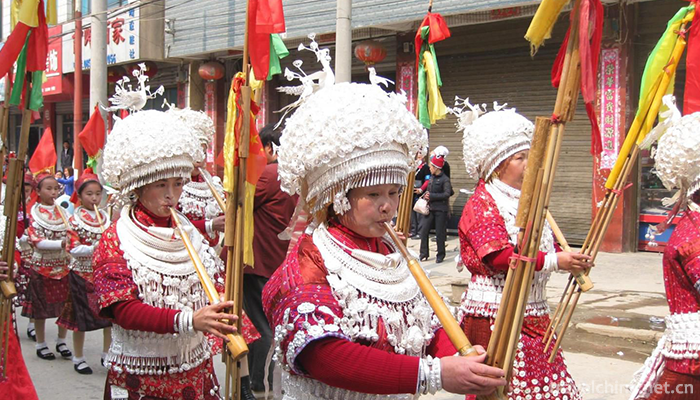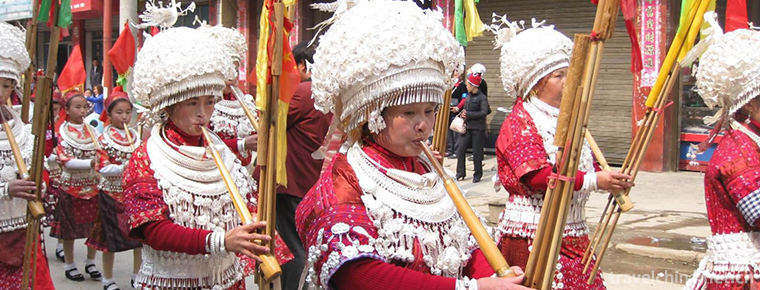Hulusheng Dance of Yi Nationality
Hulusheng Dance of Yi Nationality
Hulusheng Dance of Yi Nationality, the traditional dance of Wenshan Zhuang and Miao Autonomous Prefecture in Yunnan Province, is one of the national intangible cultural heritage.
The Yi gourd and Sheng dance is popular in Jijie Man Village, Xichou County, Wenshan Zhuang and Miao Autonomous Prefecture, Yunnan Province. Mancun is a village inhabited by the Huani people of the Yi nationality. Huani's gourd dance is an ancient folk dance of the Yi nationality. It is unique in its typical body "S" shape. It shows the lingering charm of the ancient Dian people's gourd dance. It shows that the Mancun Huani's gourd dance is inherited from the ancient Dian ancestors'dance and has its specific historical and cultural connotation.
On May 20, 2006, the Yi gourd Sheng Dance was approved by the State Council to be included in the first batch of national intangible cultural heritage list, the heritage number: III-36.
historical origin
There is a legend about the origin of gourd dancing: the ancestors of Huani people only depended on their mother Marceau and their daughter Hongmei during their migration. When the Hongmei grew up, she was swept away by a nearby snake spirit. Marceau could not fight the snake spirit, and she cried to death, lay on the barren hill tired and hungry, and picked the buckwheat seeds around her. After eating, she soon gave birth to a boy and soon grew up. One day a strange bird came flying and kept calling, "Sister Red Sister, Sister Red Sister". He went to ask his mother, and Marceau told him the story of her red sister in tears. In his anger, the boy followed the strange bird to rescue the red sister. The strange bird stopped on a huge gourd in the field. It did not go away and kept pecking the gourd with its mouth, making a strange sound. The boy picked up the gourd and made it into gourd Sheng. He came to the snake cave with the strange birds. When he blew the gourd Sheng, the sky was dark, the lightning and thunder were thundering. The snake spirit kept twisting in the shape of "S" in the sound of gourd Sheng, and the tail was completely released from the rolled red sister until he died. Sisters and brothers return home and multiply their offspring. Afterwards, Huani women used the gourd dance to expel the "snake spirit" entangled in their bodies, which was handed down.
Cultural characteristics
Stylistic features
Huani people's gourd dance is unique in its typical body "S" shape, which shows the lingering rhyme of ancient Dian people's gourd dance.
During the important festivals of Huani people, the whole village
Men and women, old and young, gathered in the courtyard. Women dressed in festive costumes, danced in circles accompanied by gourds. Buckwheat Festival is a unique and solemn festival for Huani people. Like Spring Festival, villagers usually stop working for several days, invite relatives and friends to meet, kill pigs and slaughter chickens to sacrifice ancestors and gods. During the festival, men and women, old and young, dressed in costumes, gathered in the village, danced gourd and string dances, and stayed up all night.
There are seven different dance routines for gourd Sheng dance, including tooth abuse (standing dancing), tooth celebration (starting dancing), tooth pulling (turning over), tooth drop (walking circle), tooth stabilization (wearing flowers), tooth engagement (nodding) and tooth daring (jumping forward and backward), each of which has different gourd Sheng tunes and music is rich.
Unique musical instruments
Five bamboo tubes of different lengths are inserted into the roots of bamboo or copper reeds, and the sound buckets made of cucurbits are inserted. There are sound holes on the sides of three baskets. The shortest one has sound holes on the back of the sound bucket. The longest one has a small gourd on the top to increase resonance.
Dance Rules
Hulusheng Dance is performed by males and females. When dancing, the gourd blower takes the lead. As long as the gourd strikes, the women will stand side by side, arm by arm, hand in hand with the rhythm blown out by the gourd, stamp on the ground, twist their limbs and swing their skirts, and dance. The whole gourd dance is divided into seven routes. The first way is called tooth abuse (standing jump); the second way is called tooth Qing (starting jump); the third way is called tooth pull (moving over); the fourth way is called tooth drop (walking circle); the fifth way is called tooth stabilization (walking through flowers); the sixth way is called tooth engagement (opposite nod); the seventh way is called tooth dare (jumping forward and backward). The name of each road has both the meaning of formation change and the content of dance. For example, the fourth way is "scattering cottonseed", the fifth way is "harvesting cotton", the sixth way is "spinning cotton", and the seventh way is "weaving". Each way has a fixed dance music, dance music is composed of 56123 five tones, multi-fine tune mode and commercial mode, or two modes alternate with each other. Dance music has a slow rhythm and a steady rhythm. The dynamic shape of dancing posture, with a pat of knee flexion and extension to drive the waist, chest and jaw in the "S" shape of the front and back twist, downward rhythm. When dancing, no matter how the formation changes, the circle will keep moving to the right or counter-clockwise.
Inheritance and Protection
Current situation of inheritance
Whenever the annual traditional "buckwheat festival", the whole village of men and women dressed in festival costumes, gathered in the courtyard to enjoy singing and dancing. Dancers are women, musicians are men. The dance is led by gourd and Sheng musicians blowing and dancing at the central edge. Women join hands to circle around the music and stamp their feet to the rhythm of the music. They cross their hips and dance with each other. Dance records and reflects the development history of the Huani people of the Yi nationality. It accumulates the wisdom of the Huani people of the Yi nationality, and shows the ancient folk customs and production and labor scenes.
Inheritance value
Because Huani people live on the top of high mountains for a long time, they are sparsely populated and almost isolated from the outside world.
The geographical environment at the junction of the two counties, together with the basis of life and customs, makes Huani people fully equipped with the objective conditions to retain the original dance heritage. However, due to the changes in production and life and the impact of foreign culture, the artistic characteristics and cultural connotation of the Yi gourd and Sheng dance are gradually weakening, the manifestation is becoming more and more single, and the inheritance is also not optimistic, so it should be protected and rescued as soon as possible.
The state attaches great importance to the protection of intangible cultural heritage. On May 20, 2006, the Yi gourd and Sheng dance was approved by the State Council and listed in the first batch of national intangible cultural heritage list.


-
1.Nanhai Chan Temple
Nanhai Chan Temple, a national AAAA scenic spot, is located in the southeast corner of Runan County, Zhumadian City, Henan Province, China
Time 2019-02-07 -
2.Niangziguan Scenic Area
Niangziguan is a famous pass of the Great Wall of China, known as the Ninth Pass of the Great Wall of China, and it is a must for military strategists of all dynasties.
Time 2019-02-07 -
3.Bazhen Tofu Box
Firstly, the tofu was cut into pieces and fried into crisp skin tofu. Then, eight kinds of raw materials were cooked together with the fried tofu in one pot. There are different opinions about "B
Time 2019-03-27 -
4.Brocade song
Brocade song, formerly known as Gezi or Shijin song, is also called begging tune. It was named Jinge in 1953. This is a form of singing accompanied by instrumental music.
Time 2019-05-07 -
5.Leting drum
Music Pavilion Drum is a representative form of traditional music drum book and drum music in northern China. It is widely spread in eastern Hebei, Beijing, Tianjin and northeastern Liaoning, Jilin, H
Time 2019-05-11 -
6.Twelve tunes of bronze drum
The Buyi bronze drum is one of the ancient percussion instruments of the Buyi nationality, which belongs to the precious national cultural heritage. It is made of bronze, often mixed with Suona, drums
Time 2019-06-21 -
7.University Of Science and Technology Beijing
Beijing University of Science and Technology was established in 1952 by the Department of Mining and Metallurgy of 6 famous universities in China, such as Tianjin University (formerly Beiyang Universi
Time 2019-09-06 -
8.Da Yu
Yu, surnamed Si, is famous for his life. (Yu Yu is the name). History is called Da Yu and Emperor Yu. Xia Hou Shi Chieftain Xia Dynasty The founding king. Yu is Yellow Emperor Great grandson, Zhuan Gr
Time 2019-09-07 -
9.Cai Yong
Cai Yong (133 to 192 years), Zi Bo. Chen Liu Jun Xian county (now Henan Qixian County South) People. Eastern Han Dynasty Famous ministers, writers, calligraphers, talented women Cai Wenji Father.
Time 2019-09-14 -
10.A city with a fire by one Cold thinking behind Ding Zhen hot
With the popularity of microblogging for nearly seven months, the popularity of microblogging has been created for a long time. At the same time, the hometown of Ding Zhen, Litang County, Ganzi Tibetan Autonomous Prefecture, also ushered in several times the search volume and real gold and silver tourism orders.
Time 2020-12-07 -
11.Animal resources in Leshan
The composition of the wild fauna in Leshan City is located in the transitional zone between the Palaearctic realm and the Oriental realm. It is mainly composed of the southwest region and central China region of the Sino Indian subregion in the Oriental realm.
Time 2020-12-17 -
12.Guangan waterway
Guang'an port is a "port group" composed of Guang'an port area, Huaying port area, Yuechi port area and wusheng port area distributed in Guang'an section of Qujiang River and Jialing River. Guang'an port is an important support for industrial lay
Time 2020-12-19